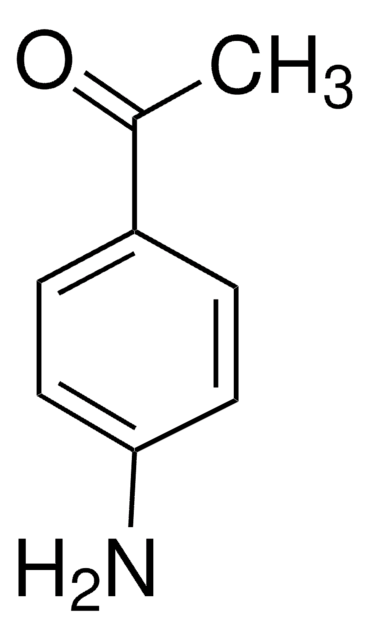100528
4′-Aminoacetanilide
99%
Synonym(s):
N-(4-Aminophenyl)acetamide, N-Acetyl-p-phenylenediamine
Sign Into View Organizational & Contract Pricing
All Photos(1)
About This Item
Linear Formula:
CH3CONHC6H4NH2
CAS Number:
Molecular Weight:
150.18
Beilstein:
742888
EC Number:
MDL number:
UNSPSC Code:
12352100
PubChem Substance ID:
NACRES:
NA.22
Recommended Products
Assay
99%
form
solid
mp
164-167 °C (lit.)
SMILES string
CC(=O)Nc1ccc(N)cc1
InChI
1S/C8H10N2O/c1-6(11)10-8-4-2-7(9)3-5-8/h2-5H,9H2,1H3,(H,10,11)
InChI key
CHMBIJAOCISYEW-UHFFFAOYSA-N
Related Categories
Signal Word
Warning
Hazard Statements
Precautionary Statements
Hazard Classifications
Eye Irrit. 2
Storage Class Code
11 - Combustible Solids
WGK
WGK 1
Flash Point(F)
383.0 °F - DIN 51758
Flash Point(C)
195 °C - DIN 51758
Personal Protective Equipment
dust mask type N95 (US), Eyeshields, Gloves
Certificates of Analysis (COA)
Search for Certificates of Analysis (COA) by entering the products Lot/Batch Number. Lot and Batch Numbers can be found on a product’s label following the words ‘Lot’ or ‘Batch’.
Already Own This Product?
Find documentation for the products that you have recently purchased in the Document Library.
Customers Also Viewed
Jennifer Hennen et al.
ALTEX, 34(2), 279-288 (2016-10-22)
In vitro approaches to address key steps of chemical-induced skin sensitization have been developed, but there is uncertainty how keratinocytes, which play a crucial role not only regarding xenobiotic metabolism but also skin inflammation, impact on a chemical's potential and
Joan Eilstein et al.
Journal of applied toxicology : JAT, 40(3), 416-433 (2020-01-09)
The abundance of xenobiotic metabolizing enzymes (XMEs) is different in the skin and liver; therefore, it is important to differentiate between liver and skin metabolism when applying the information to safety assessment of topically applied ingredients in cosmetics. Here, we
Chad D Iverson et al.
Journal of chromatography. A, 1422, 186-193 (2015-10-28)
Porous graphitic carbon (PGC) is an increasingly popular and attractive phase for HPLC on account of its chemical and thermal stability, and its unique separation mechanism. However, native PGC is strongly hydrophobic and in some instances excessively retentive. As part
Our team of scientists has experience in all areas of research including Life Science, Material Science, Chemical Synthesis, Chromatography, Analytical and many others.
Contact Technical Service













